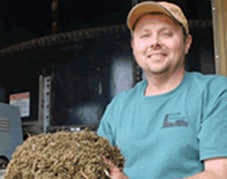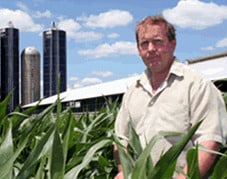When Caine Farms purchased a TMR unit in 1990, they stored haylage in a 20 x 70 foot stave silo and relied on a top unloader that plugged into the TMR.
“We needed a faster out to get feed into the TMR. With the stave we had to unload out of the top, and this was cumbersome,” says Paul Caine, who farms with his two older brothers, Pat and Dan. “Setting up the unloader wasted time. Then you have to shovel feed out, level it off and drop the unloader.” The addition of the TMR mixer spurred the purchase of Harvestores.
Their Harvestores include:
-
20 x 60 that was a 20 x 40 for 20 to 28% high moisture corn added in 1987
-
20 x 80 for haylage that can be switched to corn silage added in 1990
-
20 x 80 for haylage and corn silage erected in 1999
-
25 x 100 for haylage built in 2002
“Unloading out of the bottom is nice,” says Paul. “When it is 30 below zero you just push a button. With the staves maybe after five days you might have to go up with an ax and chop feed off the walls. With a Harvestore you just climb up the hatch, fill, close it and climb down. Easy in, easy out. There is no shoveling and setting up the unloader to make sure it will run.”
The Caine brothers own and rent 600 acres of hilly ground put into conservation tillage. Crops include corn, corn for silage and alfalfa. Heifers run on 15 acres of pasture. At Caine Farms, Dan balances the ration, Pat handles all the genetics plus accounting and Paul does machinery maintenance.
The dairy was started with a dozen cows, four of them registered. There are now 210 cows and the same number of young stock — calves to freshening. It’s a commercial herd that has been AI breeding for 50 years. They use a parallel double-8 parlor built in 1995. Their DHIA rolling herd average is 25,000 pounds of milk with a 3.85 percent test, with1,018 pounds of butterfat and 762 pounds of protein. The brothers had seven 7 x 8 100-foot storage bags in 1995.
“Bags present problems. When it rains, the skid unloader sinks in the mud and it gets messy. It’s not very convenient in the spring when the frost goes out. With a Harvestore you can blow in dry feed and it keeps fine. Just push a button and they will always run,” Caine says.
He also does not have affection for bunkers. “With a bunker, feed quality suffers. There is waste and big chunks of mold get into the feed and production suffers,” he adds.
Better Lifetime Value
Caine says the lifetime value of a Harvestore is better when he considers the costs of bags, operating a skid steer unloader and wear and tear. “Over a 20-year period, the rate of return of investment is better on the Harvestore. You can wear out a skid steer, for bags you have to rent the machine and get rid of the plastic. Labor can be a problem fighting mud in the spring, or frost or extended rainy periods,” he says.
How does a Harvestore make a difference when handling high moisture corn? “Previously, we had to pick corn and put it in a crib or hire a combine and pay for all the gas. With a Harvestore it’s the fastest, easiest, most simple thing to do for handling HMC at 20 to 28% moisture,” he adds.
“With a Harvestore, you may end up paying a little more for maintenance, but the payback is in labor savings. With a lifetime value, you can fix any part of them,” he explains. “When we take forages from the Harvestore to the TMR it’s always consistent feed. Mold tends to affect palatability, metabolism and general health. A happy cow equals consistent production.”




